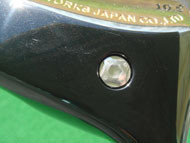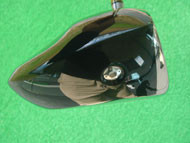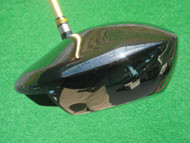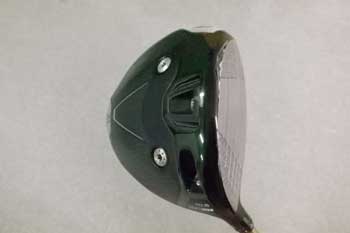Test Review: KAMUI KM-200II Driver

Today, I had the chance to test the KAMUI KM-200II driver.
The test club was the KAMUI KM-200II Driver.

The shaft was the DODECAGON.
It featured a 10.5° loft, 45.5-inch length, R-flex shaft, and a total club weight of 283g.

It’s been a while since I tested a driver from Kamui Works.
I haven’t tested many of their clubs before, but I’ve always had a positive impression.
For us veteran golfers, “Kamui” is a **big name** in the golf world.
Especially when titanium drivers first entered the market, Kamui really stood out.
Kamui was the first brand that made me realize the concept of “JDM boutique clubs.”
While many brands today are breaking away from that image, Kamui Works stays true to its roots.
This driver reflects that consistency.
Even though it’s a new model, it maintains a **classic aesthetic**.
The texture and finish remain characteristically Kamui.

The head has a large profile.
Perhaps due to its gold sole, it appears even bigger.
I wondered if it was a **high-COR model**, and it turns out, it is.
These types of non-conforming drivers are becoming more common lately.
While gold often implies a high-COR driver, that’s not always the case anymore—but it is here.
The gold finish is striking, though different from Katana’s approach.
Perhaps the plating thickness differs between the two.
Both look great, but in terms of gold finish, I personally prefer Katana.

The back of the sole has a deep concave area.
This reminded me of the KAMUI KM-300 Driver and the Akira H-5 Driver.
While not widely adopted, the fact that both Kamui and Akira use this design shows its functional value.
Even the NIKE Vapor Fly Pro had a similar feature.

There’s a cap or plug in the cavity.
It made me wonder if it’s air-filled. I’ve seen similar designs in drivers before.
Perhaps it’s filled with nitrogen at a pressure higher than atmospheric pressure.

The neck is relatively short but matches the head size well.
We no longer see shallow heads with long necks these days.

Heel side

Toe side
Weights are placed on both the heel and toe sides.
With a hex wrench, they seem easy to remove.
There were no weight markings, so the gram value is unknown. Perhaps they aren’t meant to be swapped.

This accessory adds a stylish touch.
It may not directly impact performance, but small design elements like this add luxury and appeal.

Engraved on the toe side of the sole is the phrase: “PARTICULAR TITANIUM Air Pneumatic.”
This suggests there’s a unique engineering concept behind the design.

The grip installed is a traditional style and felt comfortable.
It offered a nice balance of softness and traction.
It had a backline—which I personally don’t prefer—but many golfers might find it helpful.
I imagine if this driver had an adjustable hosel, it probably wouldn’t include a backline.
The grip surface featured several different textures and patterns.
That seems to be a common feature in modern grips.

The face design is quite distinctive.
It’s very typical of Kamui Works—something I’ve seen before on their drivers.
Sometimes, looking at the face makes me think it will have a lively pop; other times, it seems like it might hold the ball longer.
In this case, the face looked bold—what I would call “rugged.”
I expected a firm, solid impact feel.

The head is a shallow type, but not excessively so.
It feels more like a traditional shallow head from earlier generations.
Nowadays, there are many ultra-shallow designs, which makes this one look a bit thicker by comparison.


The crown shape was quite unique.
Instead of a smooth curve, it had a noticeable indentation.
It’s an uncommon design, but I believe it must serve an important aerodynamic or structural purpose.

The face (address view) looked quite distinct.
It had a pronounced closed-face appearance, or what we call a “hook face.”
While I’ve seen many hook-faced drivers and have become somewhat accustomed to them, I still struggle with them.
This particular face is the type I find difficult to get used to.

During my practice swings, the club felt very light—which I had expected.
Although the club is 45.5 inches long, it somehow felt even longer.
Maybe the shaft’s delayed return gave that impression.
I did several practice swings to get the timing down.

When addressing the ball, I found it difficult to set up properly.
It looked like it would send the ball too far left, and I couldn’t adapt.
Given the large head, the length, and the lightweight feel, I assume the closed face helps enhance draw bias and promote straighter shots.
But for me, that psychological discomfort was hard to overcome.
I struggled to find a good takeaway rhythm, so I decided to ignore direction and just focus on swinging naturally.
Test Session Begins
I couldn’t get used to the **impact sound** at all.
From the very first shot, I thought, “Whoa, what a loud sound… This isn’t for me.”
It was an extremely high-pitched and loud sound.
I couldn’t help but worry about how it might disturb those around me.

It was a bitterly cold day, yet the driving range was nearly full—making me even more concerned about the noise.
I knew I couldn’t keep hitting balls like this, so I stepped away from the bay, sat down, and took a break.
I bought a hot canned coffee from a vending machine to warm up and clear my head.
High-COR drivers used to have that “tinny” sound, but more recent models have improved acoustics. I expected the same here—but was wrong.
I didn’t anticipate this kind of harsh sound.
Some players may be fine with it, but I absolutely couldn’t handle it.
After taking a short break, I tried hitting again—but it still didn’t work for me.
I couldn’t get used to it, no matter what.
It wasn’t just that I disliked the sound personally—it also felt too loud for the environment.
Even though I wanted to keep hitting due to the cold, this sound stopped me from doing so.

The **feel at impact** was slightly on the firm side.

The ball launched easily.

In terms of **forgiveness**, the ball had too much draw bias—I hit a hook right from the start.

As for **distance performance**, I found it a bit hard to match my swing.
This is not a driver you can aggressively swing at—it felt more like one to gently guide.

Regarding **workability**, it tended to draw too much, and I couldn’t hit enough shots to explore it thoroughly.

I wanted to ease into it slowly, but the sound was too off-putting—I ended up hitting only three shots.
Normally, I hit a lot more, but I just couldn’t continue with a sound I disliked so much.
I believe the manufacturer intentionally designed it with this acoustic profile, but for me, it was a completely alien and uncomfortable sound.
Because I only managed to hit three shots, I couldn’t analyze it in full detail.

This driver just wasn’t a match for me—but I’m looking forward to what Kamui Works releases next.
More reviews on Kamui Works clubs
Want to read the original article in Japanese? Click here








